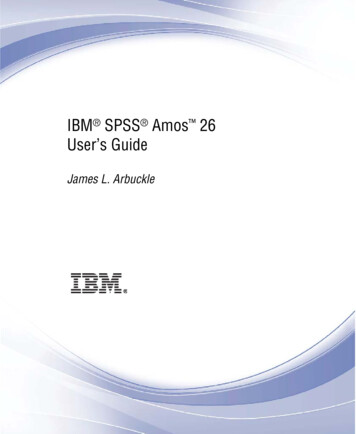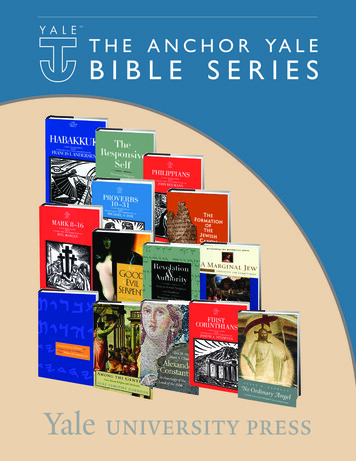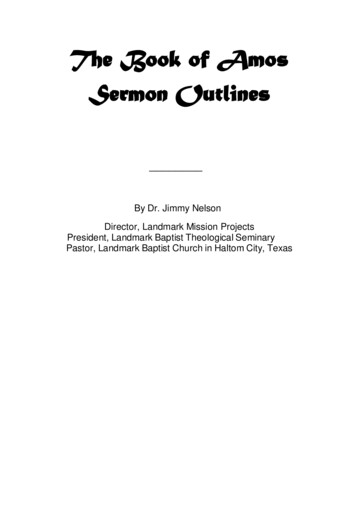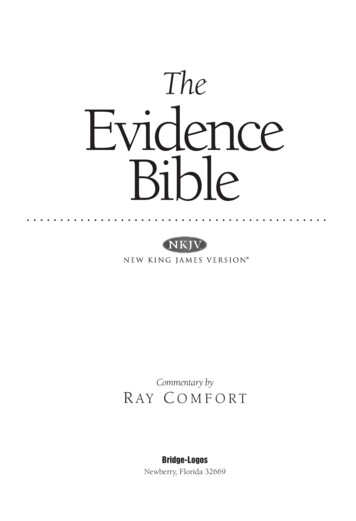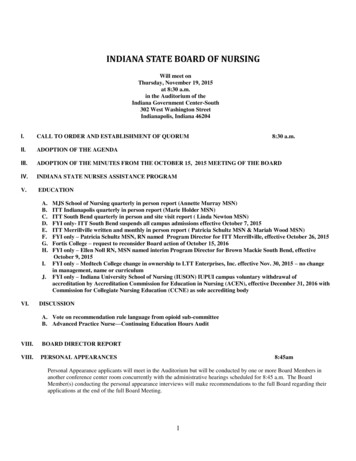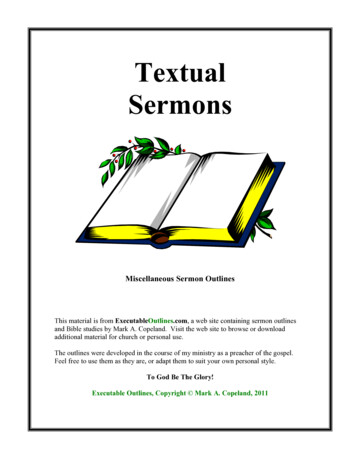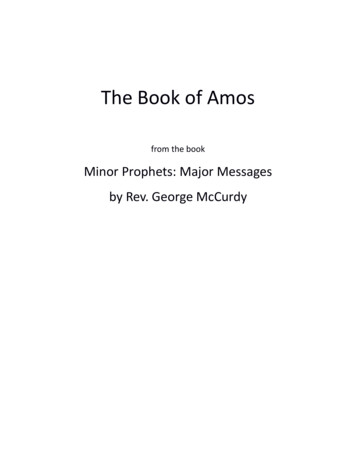
Transcription
The Book of Amosfrom the bookMinor Prophets: Major Messagesby Rev. George McCurdy
ContentsPreface. 6How To Use This Study Guide. 6Introduction. 8Major and Minor Prophets. 8Who Was This Man Called Amos?. 9What Conditions in the Northern Tribes Made Amos’ Prophecy Necessary?.10Chapter One. 12Amos 1:1-2. 12Amos 1:3-5. 15Amos 1:6-8. 20Amos 1:9-10. 24Amos 1:11-12. 26Amos 1:13-15. 29Chapter Two. 35Amos 2:1-3. 35Amos 2:4-5. 39Amos 2:6-8. 42Amos 2:9-11. 47Amos 2:12-16. 52Chapter Three. 58Amos 3:1-2. 582
Amos 3:7-8. 69Amos 3:9-10. 72Amos 3:11. 75Amos 3:12. 78Amos 3:13-15. 80Chapter Four. 85Amos 4:1-3. 85Amos 4:4-6. 89Amos 4:7-8. 94Amos 4:9. 97Amos 4:10-11. 100Amos 4:12-13. 104Chapter Five. 108Amos 5:1-3. 108Amos 5:4-9. 112Amos 5:10-13. 118Amos 5:14-15. 123Amos 5:16-20. 126Amos 5:21-22. 130Amos 5:23-25. 133Amos 5:26-27. 137Chapter Six. 139Amos 6:1-2. 1393
Amos 6:3-6. 142Amos 6:7-9. 147Amos 6:10-12. 149Amos 6:13-14. 154Chapter Seven. 157Amos 7:1. 157Amos 7:2-6. 159Amos 7:7-9. 163Amos 7:10-13. 166Amos 7:14-16. 169Amos 7: 17. 171Chapter Eight. 174Amos 8:1. 174Amos 8:4-6. 178Amos 8:7-10. 182Amos 8: 11-14. 188Chapter Nine. 193Amos 9:1-5. 193Amos 9:6. 198Amos 9:7. 202Amos 9:8-10. 205Amos 9:11-12. 209Amos 9:13-15. 2134
Epilogue: A Summary of the Nine Chapters of Amos.219Chapter One. 219Chapter Two. 219Chapter Three. 219Chapter Four. 219Chapter Five. 220Chapter Six. 220Chapter Seven. 220Chapter Eight. 220Chapter Nine. 2205
PrefaceThe book of Amos is one of the books of the Word. Not much has been written aboutit in the New Church. Since I started working on this study of Amos, I have searchedour library holdings with the hope I would turn up a hidden or forgotten study bysome New Church scholar. Although there are sermons using a verse or part of achapter of Amos as a text, I have found no detailed study of Amos or other books ofthe Minor Prophets. Why not? Is there a perception that the Writings lack a verseby-verse explanation of these Prophets?So far, my research has uncovered several thorough New Church books on the MajorProphets, such as Isaiah, Daniel, and Ezekiel. The absence of similar books on theMinor Prophets motivated me to undertake a study guide approach to filling thisvoid. I hope this first study guide will prove helpful to others and that additionalstudy guides will follow this one. Ultimately, I want the Minor Prophets to beaccessible and hope to contribute to their study and use in the church. Most of all, I’dlike this effort to be a challenge so that others will be encouraged to build on andimprove this pilot project.How To Use This Study Guide1. A slow, unhurried reading of Amos is essential. Read each chapter before youlook at the related section of the Study guide. Read the chapter again while youare using the study guide, and read it a third time when you are finished. Thisprocess will give you a powerful sense of the series of events and meanings ineach chapter. It is important to feel comfortable with all the names, places, andannouncements in Amos’ prophecy. When possible, some historical informationwill be included in the study guide to increase reading comprehension andenhance application.The book of Amos is not an easy work to read and understand. Unlike some ofthe prophets—Jonah or Hosea—Amos doesn’t tell a story that is easy toremember. He brings prophecies against neighbors of Israel, mentioning namesand places one can only recognize with the help of maps and reference books.One has to wade through many historical facts to catch a glimpse of the messagein Amos, so it is important to balance history with solid research of the spiritualsense. Researching can require a table full of books and hours of comparing andcontrasting meanings that can be drawn from the internal sense. This studyguide intends to help the researcher by including a full set of quotes so that he orshe may spend less time juggling books and more time reflecting on the issuesthe internal sense presents. My hope is that the reader will concentrate on theprocess of applying doctrine to life.2. As you read Amos, there are several resources you will want to use with thisstudy guide. The first is a book of the Writings called Summaries of the Internal6
3.4.5.6.7.8.Sense of the Prophets and Psalms.1 This work includes a verse-by-verse overviewof each of the nine chapters of Amos. The overview gives a general statementabout the internal sense. Our research will move us toward the particulars of theinternal sense.Another important reference tool is Searle’s General Index to Swedenborg’sScripture Quotations. This reference shows where in the Writings a verse(s) ofthe Word is either explained specifically or used to illustrate a doctrinal pointthat we can add to our study. There is also another use of this work. As we study,each researcher will be led by the Lord’s Providence in myriad of ways andaccording to specific needs or states. Knowing how to use this book will help uslook up related passages in the Word that will add to our knowledge of the threefold Word.You will soon discover that not every verse, word, name, etc. is directly quotedand explained in the Writings. However, there are often references to the samename, place, or thing in the explanation of a different verse of the Word. Thehope is that reflection on these other references and their associated doctrinewill help us see possible applications to our study of Amos. We will need to use“derived doctrine.” Please don’t run away from this maligned term. If we use itproperly, admitting openly that it is derived, we bring no harm to the internalsense. Think about it for a minute. The Writings give us a verse-by-verseexplanation of Genesis, Exodus, and Revelation. Do we stay away from the otherbooks of the Word because the Lord didn’t reveal them in the Writings in thesame way He did Genesis, Exodus, and Revelation? I think not. We must look for,find, and wisely use “derived doctrine” with a humble acknowledgment that wehave tried to apply doctrine with a degree of human prudence.Keep a notebook handy during your study times. Write out insights, questions,and any summaries you find helpful in organizing your thoughts about eachchapter. The goal of this study guide is not to give a detailed summary of theinternal sense but to start the researcher’s quest for deeper insights.There is a wonderful explanation of Amos, chapter 8, in the Dole Bible StudyNotes, Volume 4. There you will see an example of historical and spiritualinformation corroborating one another. It is well worth your time to read andreflect on this explanation. You might also enjoy looking at the Sower Notes,Volume III, Chapter 58.At the end of each chapter in the study guide, you will find a study review. Thereview includes a summary of each section to help you reinforce and build onyour understanding of several of the key points.Begin each study unit with a devotional prayer asking the Lord to guide anddirect your thoughts. Certainly beginning in this sphere has the power to inspireand open our minds with a higher spiritual priority that will keep us in thecompany of the Lord’s angels. As the Writings teach, we must seek to love truthfor truth’s sake. Such an approach will free each reader from preconceived ideasthat might limit his or her ability to “see” the intent and message of the Lord’sWord.17
IntroductionBefore we begin our study, it will be helpful to learn some background informationabout the books of the prophets and their approximate dates.MAJOR AND MINOR PROPHETSLet’s begin with a brief description of what the terms “Major Prophets” and “MinorProphets” mean. In the Old Testament, there are 16 books referred to as the books ofthe Prophets. Biblical scholars have divided the 16 books into two categories.Augustine was the first person to use the terms “Major” and “Minor” to indicate thesize of the books, not their relative importance. The Minor Prophets contain fewerchapters than those of the Major Prophets.Scholars do not agree on the timeline of the prophets. I found at least ten differenttimelines. None of them agree completely on dates. If I were to simplify the researchinformation I would say there are essentially two timelines that seem to have theacceptance among the scholars. So I offer both for your consideration.The Minor ProphetsAmos750 BC *Obadiah840-830 BCHosea745-734 BC *Joel830-750 BCMicah701 BCJonah780-740 BCZephaniah628-626 BCHosea765-725 BCNahum614-612 BCAmos760 BCHabakkuk605-600 BCMicah740-700 BCHaggai520 BCNahum640-620 BCZechariah520-519 BCZephaniah640-609 BCMalachi460 BCHabakkuk680-605 BCObadiah400-350 BCHaggai520 BCJoel350 BCZechariah520-480 BCJonah300 BCMalachi420-400 BC8
The Major ProphetsIsaiahJeremiahEzekielDaniel742-687 BC *627-580 BC593-563 BC605-536 BCWHO WAS THIS MAN CALLED AMOS?Amos was a shepherd in a region called Tekoa, about six miles south of Bethlehem.Commentaries describe the area as somewhat rugged, rocky, and with sparsegrazing fields. Shepherds in that region had to make extensive trips to feed theirflocks.In the book of Amos, we find two uses Amos performed: he kept sheep (Amos 1:1),and he cultivated sycamore trees (Amos 7:14). One translation says that he was a“pincher” of the sycamore tree blossom. This means he was a pruner. The sycamoretree in that region produced a low quality fig. Its taste was not as exquisite as that ofother fig trees, so it was called a poor man’s fig tree. When overwhelmed by hunger,the poor availed themselves of the sycamore tree’s abundance.Unlike the “sons of the Prophets” or the priests, Amos had no training or preparationprior to his call to bear a message from the Lord to the ten Northern Tribes of Israel.Amos appeared to the people, spoke the message, and then departed, never to beheard of again. It is interesting to note that his name is not mentioned anywhere elsein the Word except for Luke 3:25 and most biblical scholars think that this verseactually refers to Amoz, the father of the prophet Isaiah.Amos’ name means “burden bearer.” That seems quite appropriate for the task athand. When we study Amos, our burden is to think from essence and not person.Rather then getting caught up in Amos himself, we need to get caught up in what hisprophecies represent. How can we find ourselves in his text? Where does eachlesson challenge us as members of the New Church?We can learn more about who Amos was in the Word by considering his two uses—shepherd and pruner of sycamore trees. In Arcana Coelestia (AC) 343, we are toldthat a shepherd represents a person who exercises charity. Someone who leads andteaches is called a shepherd, and those who are led and taught are called a flock.This shepherd tended sycamore trees, the “poor man’s fig trees.” A sycamore treedenotes external truth, and a fig tree represents external good (AC 7553).Putting the two uses of Amos together may help us understand why he was chosento go to the Northern Tribes. They had fallen on spiritually hard times. The people asa flock, and their priests as shepherds, were in a wilderness state, and their external9
lives were about as tasteless as the figs on the sycamore tree. Genuine obedience tothe Lord was at a low point. The Lord always seeks to improve, or lift, the quality ofHis children. He sought to help the people shun evils as sins so they might do thework of repentance. Until the external part of a person is willing to be put in order,the person resists the ways of the Lord. Because the Israelites in the Northern Tribeswere in this state, hard prophecies had to be spoken to them. The Lord chose Amosto reveal serious spiritual disorders.Fear, predictions of doom, and hard sayings about spiritual disorder are not topicspeople enjoy. We prefer happier themes. But when the Word says the Lord “roarsfrom Mount Zion,” we need to remember the “roaring” speaks of His zeal and love,not anger. The Lord doesn’t get angry. He holds up a mirror so that His people maysee what they are doing to themselves. He wants us all to shun evils as sins to keepfrom losing our souls. “For what will it profit a man, if he gains the whole world andforfeits his life?” (Matt. 16:26)WHAT ARE SOME OF THE CHARACTERISTICS OF THE PROPHETS?To learn more about prophets, read AC 2534. Essentially, the Writings teach us fourthings about the prophets in the Word.1. They delivered the words of the Lord and not their own.2. The messages they gave to the people often came to them in dreams orvisions.3. Often, the prophets had no idea what the prophecies meant.4. The prophets had to memorize or write down their prophecies in order topass them on.Biblical scholars think that Amos wrote his prophecies down.WHAT CONDITIONS IN THE NORTHERN TRIBES MADE AMOS’ PROPHECYNECESSARY?The Oxford Annotated Bible prefaces the book of Amos with a useful summary,excerpted here:During the long and peaceful reign of Jeroboam II (786-746 BC) Israel attained aheight of territorial expansion and national prosperity never again reached. Themilitary security and economical affluence which characterized this age were takenby many Israelites as signs of the Lord’s special favor toward them which they feltthey deserved because of their extravagant support of the official shrines.Amos.was called by God.to the difficult mission of preaching harsh words in asmooth season. He denounced Israel, as well as her neighbors, for reliance uponmilitary might, and for grave injustice in social dealings, abhorrent immorality, andshallow, meaningless piety.This description highlights the main problems in the Northern Tribes:10
1. They were experiencing a “smooth season”—things were going well foreveryone, and people felt a comfortable spiritual laziness.2. They gloried in their territorial growth and wealth.3. They thought they were a favored people, that life owed them this prosperity.4. Their military security allowed them to trust more in their own power andless in the Lord’s protection.5. They committed serious injustices in their social interactions with oneanother.6. Their behavior was immoral.7. Their worship became shallow and meaningless.8. They saw their financial support of the shrines as merit worthy of specialstatus with the Lord.All of these problems show us why the Lord needed to “roar out of Zion.” TheNorthern Tribes had failed to pursue eternal values. Instead, they longed for thethings that thieves, rust, and moths could take from them. We can also see why manyof Israel’s neighbors received warnings in the prophecy of Amos. The Lord wantedIsrael to see in others what was so deeply involved in their hearts.Israel thrilled at hearing the prophecy against others but resented the prophecywhen the Divine light exposed their own dark motives. The Oxford summarycontinues:Amos’ forceful, uncompromising preaching brought him in conflict with the religiousauthorities of his day.A priest named Amaziah (complained and accused Amos oftreason and) sought to have him expelled.from the royal sanctuary at Bethel and(Amos was) commanded not to prophesy there again.With this information in mind, let’s begin the study of Amos. Remember to use anotebook. Write out impressions, questions, and insights for your own reflection orto share in the group with whom you are studying.11
Chapter OneAMOS 1:1-2“The words of Amos, who was among the sheep breeders of Tekoa, which he sawconcerning Israel in the days of Uzziah king of Judah, and in the days of Jeroboam theson of Joash, king of Israel, two years before the earthquake. And he said:The Lord roars from Zion,and utters His voice from Jerusalem;The pastures of the shepherds mourn,and the top of Carmel withers.”Passages From the WritingsProphets and Psalms (P&P) “The Lord concerning the Word and doctrine thence.” (verses 1, 2)Arcana Coelestia (AC) 3995[3] “For this reason spotted is expressed in the original language by aword that also means lambs (as in Isa xl. 10, 11); and speckled by a word thatalso means a herdsman (as in 2 Kings iii. 4; Amos i. 1).”Apocalypse Revealed (AR) 612 “.therefore by Zion.is meant the church everywhere.It is called Mount Zionbecause by a mountain is signified love.That by Mount Zion is signifiedheaven and the church where the Lord alone is worshiped, may appear.”Amos 1:2 is cited along with other references.Apocalypse Explained (AE) 601[15] “In Amos (i.2).roaring from Zion signifies grievous distress, and the voicefrom Jerusalem lamentation; the mourning of the habitation of theshepherds, and the drying up of the head of Carmel, signifies because of thevastation of all the goods and truths of the church; the habitation of theshepherds signifying all the goods of the church; the head of Carmel signifiesthe truths of the church, because in Carmel there were vineyards, and winesignifies the truths of the church.”12
AE 601[16] “.the roaring like that of a lion signifies grief and lamentation over thevastation of Divine truth in the church by the falsities of evil.”AE 850[15] “In Amos.(i.2) to roar and the roaring of a lion, when predicated of Jehovah,signify an ardent zeal for protecting heaven and the church, and for savingthose who are therein by the Divine truth and its power, which is done bydestroying the evils and falsities that rise up out of hell.”Derived DoctrineTekoa We are not given the correspondence of this town. We do know that it lay 6miles south of Bethlehem. Bethlehem represents “the Word in its spiritualsense; the Lord willed to be born there because He is the Word.” (AE 700[9]) The word Bethlehem means “house (place) of bread” or food. MightTekoa’s southerly distance from Bethlehem represent the way that thechildren of Israel, in their minds, were moving away from relying on the Wordas the house of bread?“South represents intelligence, which is acquired by knowledges of spiritualand celestial truths.” (AC 1458) Is this geographic representation there toremind us that the Lord is going to return the church to intelligence aboutspiritual and celestial truths?The Lord’s Concerns “Israel in the days of Uzziah, one of the good kings of Judah.signifies theLord’s royalty, or some aspect of His kingdom.” (AC 1409[4]) “Royalty of theLord signifies heaven and the church.” (AR 664) These quotations indicate therange of the Lord’s concern for His heavenly kingdom and the church. He isconcerned about everyone in His kingdom, not just the ancient Israelites.The Reigns of Joash and Jeroboam Jeroboam the son of Joash: The Writings do not provide the specificsignifications of these two kings. However, when we look at the history oftheir reigns, we can see a spiritual decline from moderate “piety” andacknowledgment of the Lord by Joash to brazen disorder under Jeroboam’sleadership. During their reigns, the quality of worship declined: worship of“strange gods” and use of temple prostitutes were permitted in the temple.Spiritually wise and prudent kings and priests would never have allowed13
these practices to enter the temple of the Lord. The kings and priest became“people pleasers” instead of pursuing spiritual wisdom. The consequent comingling of holy and unholy things was abhorrent to the Lord and adegradation of all that gave Israel its distinctiveness and representation.Although the people looked and acted happy with their lives during this time,the Lord saw within their hearts the seed of spiritual death, and He needed toexpose its deadliness.The Earthquake The end of the church (or its perversion) is described in the Word byconcussions, overturning, and sinking of the earth. Consequently,earthquakes signify changes of the state of the church. (AR 33, 711.)Two Years In the internal sense, a “year” does not refer to a year of time. “.angels, whoare in the internal sense of the Word, cannot have an idea of anyyear.therefore instead of a year they have an idea of what is full in respect tostates of the church, and what is eternal in respect to states of heaven.” (AC2906[10]) Our verse sets its time as “two years before the earthquake.” Why?When the Word refers to “two” of anything, it is often a reference to the willand the understanding. Considering the meaning of an earthquake (seeabove), could “two years” represent the state of the will and understa
The book of Amos is not an easy work to read and understand. Unlike some of the prophets—Jonah or Hosea—Amos doesn’t tell a story that is easy to remember. He brings prophecies against neighbors of Israel, mentioning names and places one can
